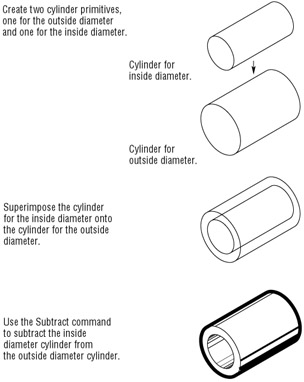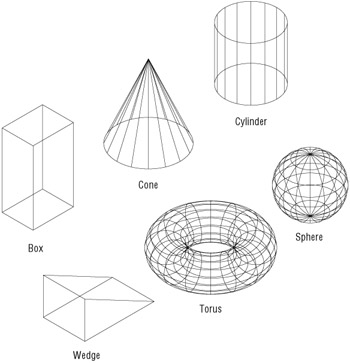Understanding Solid Modeling
Solid modeling is a way of defining 3D objects as solid forms rather than as wireframes with surfaces attached. When you create a 3D model by using solid modeling, you start with the basic forms of your model ”cubes, cones, and cylinders , for instance. These basic solids are called primitives. Then, using more of these primitives, you begin to add to or subtract from your basic forms.
For example, to create a model of a tube, you first create two solid cylinders, one smaller in diameter than the other. You then align the two cylinders so they are concentric and tell AutoCAD to subtract the smaller cylinder from the larger one. The larger of the two cylinders then becomes a tube whose inside diameter is that of the smaller cylinder, as shown in Figure 18.1. Several primitives are available for modeling solids in AutoCAD (see Figure 18.2).

Figure 18.1: Creating a tube by using solid modeling
You can join these shapes ”box, wedge , cone, cylinder, sphere, and donut (or torus ) ” in one of four ways to produce secondary shapes. The first three, demonstrated in Figure 18.3 using a cube and a cylinder as examples, are called Boolean operations. (The name comes from the nineteenth-century mathematician George Boole.)
The three Boolean operations are as follows :
Intersection Uses only the intersecting region of two objects to define a solid shape.
Subtraction Uses one object to cut out a shape in another.
Union Joins two primitives so they act as one object.
The fourth option, interference, lets you find exactly where two or more solids coincide in space ”similar to the results of a union. The main difference between interference and union is that interference enables you to keep the original solid shapes, whereas union discards the original solids, leaving only their combined form. With interference, you can have AutoCAD either show you the shape of the coincident space or create a solid based on the coincident space's shape.
Joined primitives are called composite solids. You can join primitives to primitives, composite solids to primitives, and composite solids to other composite solids.
Now let's take a look at how these concepts let us create models in AutoCAD.

Figure 18.2: The solid primitives
| Tip | To simplify the exercises in this chapter, the instructions don't specify inches or centimeters. This way, users of both the metric and Imperial measurement systems can use the exercises without having to read through duplicate information. |
EAN: 2147483647
Pages: 261